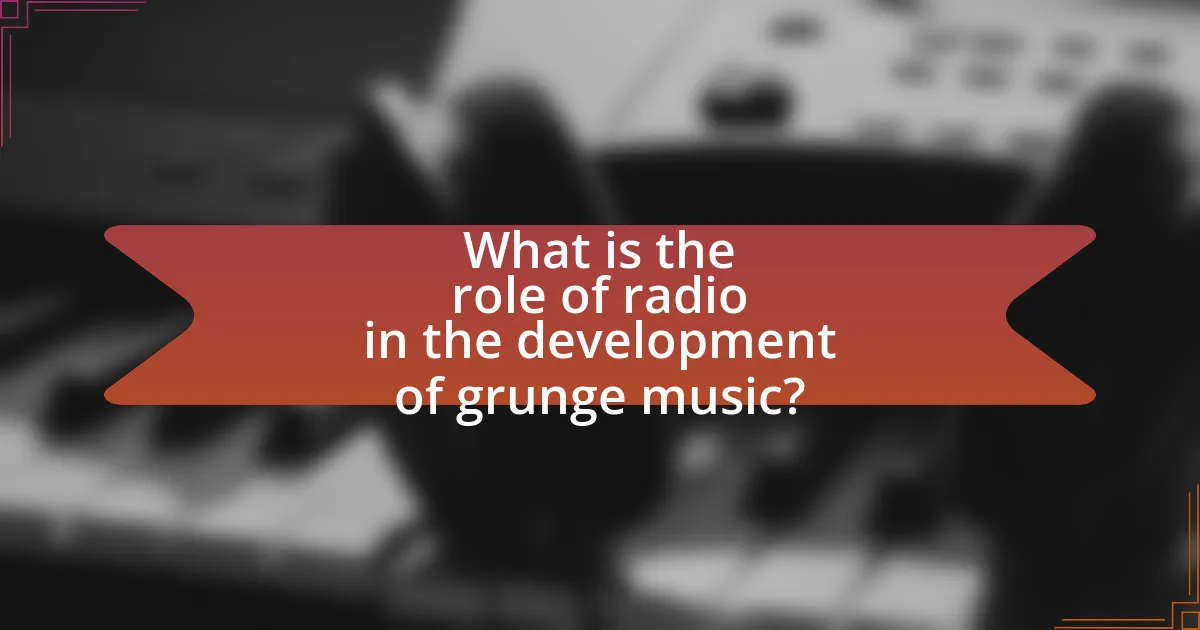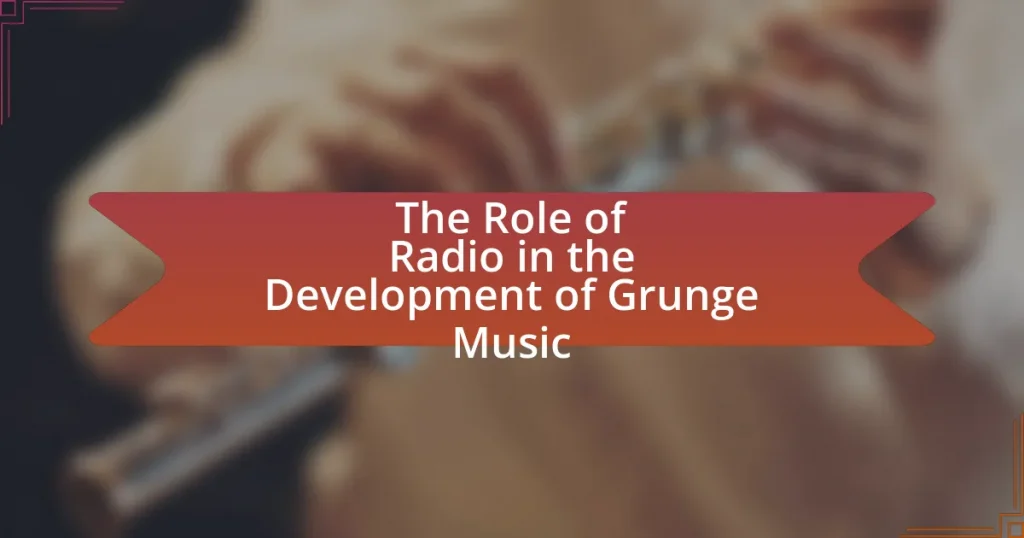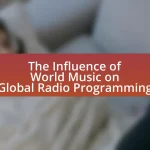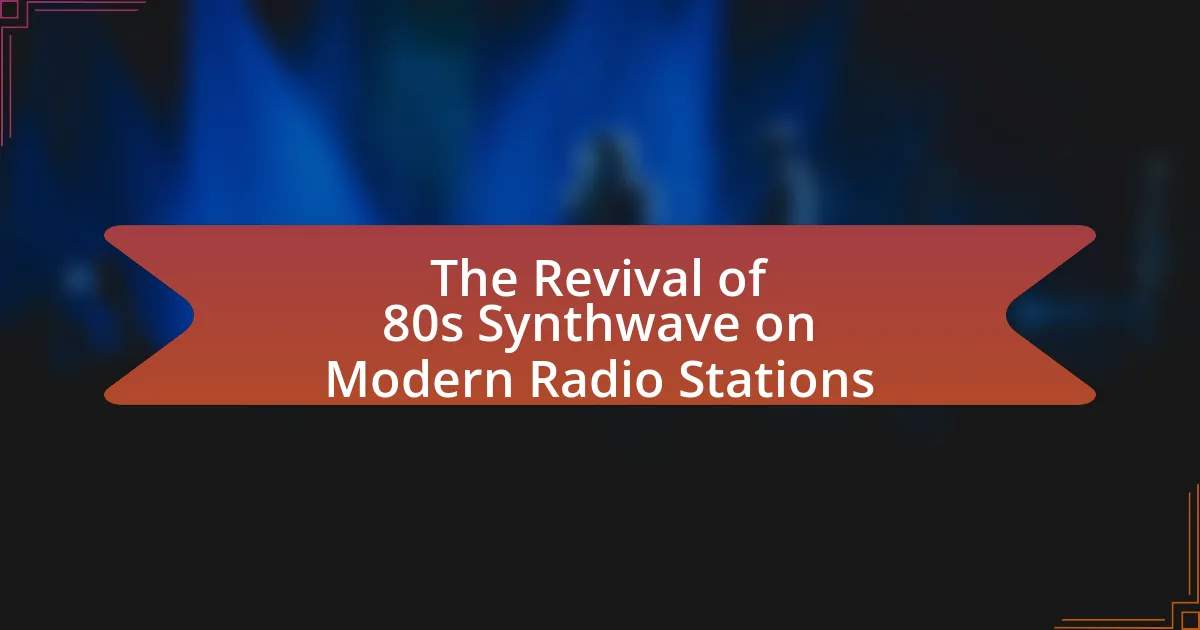The article examines the pivotal role of radio in the development and popularization of grunge music during the late 1980s and early 1990s. It highlights how radio stations, particularly in Seattle, provided a platform for bands like Nirvana, Pearl Jam, and Soundgarden, facilitating their transition from underground acts to mainstream success. Key aspects discussed include the influence of specific radio stations, the impact of airplay on album sales and audience demographics, and the challenges faced by grunge music within the commercial radio landscape. The article also explores how radio shaped the sound and style of grunge, the strategies employed by bands to leverage radio for exposure, and the lessons that can be learned for emerging genres today.

What is the role of radio in the development of grunge music?
Radio played a crucial role in the development of grunge music by providing a platform for the genre to reach a wider audience. In the late 1980s and early 1990s, radio stations, particularly in Seattle, began to feature grunge bands like Nirvana, Pearl Jam, and Soundgarden, which helped popularize the sound characterized by heavy guitar riffs and introspective lyrics. The success of Nirvana’s “Smells Like Teen Spirit” on alternative rock radio in 1991 exemplified how radio exposure could propel a band to mainstream success, leading to a surge in grunge’s popularity across the United States. This exposure not only increased album sales but also influenced the music industry, prompting record labels to sign more grunge acts, thereby solidifying the genre’s place in rock history.
How did radio influence the emergence of grunge music?
Radio significantly influenced the emergence of grunge music by providing a platform for underground bands to reach wider audiences. In the late 1980s and early 1990s, radio stations, particularly in Seattle, began to play tracks from local grunge bands like Nirvana and Soundgarden, which helped to popularize the genre. The rise of alternative rock radio formats allowed for the inclusion of grunge music in mainstream playlists, leading to increased visibility and commercial success for these artists. For instance, Nirvana’s “Smells Like Teen Spirit” received heavy rotation on radio stations, which was pivotal in propelling the band and the grunge movement into the national spotlight.
What specific radio stations played a key role in promoting grunge bands?
KEXP and KNDD (The End) were key radio stations in promoting grunge bands. KEXP, based in Seattle, played a significant role by featuring local grunge acts like Nirvana and Soundgarden, helping to elevate their visibility. KNDD, also in Seattle, was influential in the 1990s by providing airplay for grunge music, contributing to the genre’s mainstream success. Both stations were instrumental in shaping the grunge movement and connecting audiences with emerging bands.
How did radio airplay affect the popularity of grunge music?
Radio airplay significantly boosted the popularity of grunge music by providing widespread exposure to bands like Nirvana, Pearl Jam, and Soundgarden. This exposure led to increased album sales and concert attendance, as radio stations played key tracks from these artists, notably Nirvana’s “Smells Like Teen Spirit,” which became an anthem of the genre. The impact of radio was evident in the early 1990s when grunge music transitioned from underground scenes in Seattle to mainstream success, with the Billboard charts reflecting this shift; for instance, Nirvana’s “Nevermind” reached number one on the Billboard 200 in 1992, largely due to heavy radio rotation.
Why was radio important for grunge music’s reach and accessibility?
Radio was crucial for grunge music’s reach and accessibility because it provided a platform for emerging bands to gain exposure to a wider audience. During the early 1990s, radio stations, particularly alternative and college radio, played a significant role in promoting grunge acts like Nirvana, Pearl Jam, and Soundgarden, which helped them break into mainstream popularity. For instance, Nirvana’s “Smells Like Teen Spirit” received extensive airplay, leading to a surge in album sales and a cultural shift towards grunge music. This accessibility through radio allowed listeners across the country to discover and connect with the genre, contributing to its rapid rise and influence in popular music.
What demographics were primarily reached by grunge music through radio?
Grunge music primarily reached young adults and teenagers, particularly those aged 18 to 34, through radio. This demographic was drawn to the genre’s themes of disillusionment and rebellion, which resonated with their experiences during the early 1990s. The popularity of grunge on radio stations, especially alternative rock formats, significantly contributed to its mainstream success, with bands like Nirvana and Pearl Jam topping charts and gaining substantial airplay. According to a 1993 survey by the Radio Advertising Bureau, alternative rock stations saw a significant increase in listenership among this age group, highlighting the genre’s impact on youth culture during that era.
How did radio help in breaking regional barriers for grunge music?
Radio played a crucial role in breaking regional barriers for grunge music by providing a platform for the genre to reach a national audience. Through the airwaves, stations like Seattle’s KCMU and later national networks began to play grunge bands such as Nirvana and Pearl Jam, which allowed listeners from various regions to discover and connect with the music. This exposure facilitated the genre’s rise beyond its Pacific Northwest origins, leading to mainstream success and a broader cultural impact, evidenced by Nirvana’s “Nevermind” reaching number one on the Billboard charts in 1992.

How did radio shape the sound and style of grunge music?
Radio significantly shaped the sound and style of grunge music by providing a platform for underground bands to reach wider audiences. In the late 1980s and early 1990s, radio stations, particularly college and alternative rock stations, began to play grunge tracks, which helped popularize the genre. For instance, Seattle-based bands like Nirvana and Soundgarden gained national attention through airplay on influential stations such as KCMU in Seattle, which played a crucial role in promoting local acts. This exposure not only increased the visibility of grunge music but also influenced its sound, as radio playlists began to reflect the raw, distorted guitar riffs and introspective lyrics characteristic of the genre. The success of Nirvana’s “Smells Like Teen Spirit,” which received heavy rotation on mainstream radio, exemplifies how radio helped propel grunge into the mainstream, ultimately shaping its style and cultural impact.
What characteristics of grunge music were highlighted by radio broadcasts?
Radio broadcasts highlighted several key characteristics of grunge music, including its raw sound, emotional intensity, and themes of disillusionment. The raw sound was often marked by heavy guitar riffs, a lo-fi production aesthetic, and a blend of punk rock and heavy metal influences. Emotional intensity was conveyed through lyrics that expressed feelings of angst, alienation, and social commentary, resonating with a disenchanted youth. Themes of disillusionment were prevalent, reflecting a rejection of mainstream culture and consumerism, which was frequently articulated in the music and interviews featured on radio shows. These characteristics were instrumental in shaping the identity of grunge music and its appeal to listeners during the early 1990s.
How did radio playlists influence the sound of grunge music?
Radio playlists significantly influenced the sound of grunge music by promoting specific bands and songs that shaped the genre’s characteristics. The inclusion of grunge tracks on influential radio stations, particularly in the early 1990s, helped to popularize the raw, distorted guitar sounds and introspective lyrics that defined grunge. For instance, Seattle-based stations like KEXP and KNDD played pivotal roles in introducing bands such as Nirvana, Pearl Jam, and Soundgarden to a wider audience, which in turn encouraged other artists to adopt similar styles. This exposure led to a homogenization of sound within the genre, as bands sought to replicate the elements that resonated with listeners and radio programmers alike. The success of Nirvana’s “Smells Like Teen Spirit,” which received heavy rotation on radio playlists, exemplifies how radio not only shaped public perception but also influenced the musical direction of emerging grunge artists.
What role did DJ personalities play in shaping grunge music’s image?
DJ personalities played a crucial role in shaping grunge music’s image by serving as influential tastemakers who introduced and promoted the genre to a wider audience. Notably, DJs like Kevin Weatherly and Steve Jones were instrumental in featuring grunge bands such as Nirvana and Pearl Jam on their radio shows, which helped to elevate the genre’s visibility. Their endorsement and commentary provided a platform that not only showcased the music but also framed the cultural narrative surrounding grunge, emphasizing its authenticity and connection to youth disillusionment. This exposure was pivotal in establishing grunge as a significant movement in the early 1990s, as radio airplay directly correlated with increased album sales and concert attendance for grunge artists.
How did radio contribute to the evolution of grunge music over time?
Radio played a crucial role in the evolution of grunge music by providing a platform for underground bands to reach wider audiences. In the late 1980s and early 1990s, stations like Seattle’s KCMU and later national outlets such as MTV’s “120 Minutes” began to feature grunge artists, which helped to popularize the genre. This exposure led to significant commercial success for bands like Nirvana and Pearl Jam, whose songs received heavy rotation on alternative rock radio. The influence of radio not only facilitated the dissemination of grunge music but also shaped its identity, as listeners connected with the raw, authentic sound that was often a departure from mainstream rock at the time.
What changes in radio programming reflected shifts in the grunge genre?
Radio programming shifted significantly to accommodate the grunge genre, particularly in the early 1990s when stations began to feature more alternative rock and grunge bands. This change was marked by the increased airplay of artists like Nirvana, Pearl Jam, and Soundgarden, which reflected a broader cultural acceptance of the genre. The success of Nirvana’s “Smells Like Teen Spirit” in 1991 catalyzed this shift, leading to the inclusion of grunge tracks in mainstream playlists and the establishment of dedicated alternative rock radio stations. By 1993, Billboard reported that alternative rock had become one of the most popular formats, indicating a substantial transformation in listener preferences and radio programming strategies.
How did listener feedback through radio impact grunge music trends?
Listener feedback through radio significantly influenced grunge music trends by shaping the selection of songs that received airplay and promoting the genre’s underground artists. Radio stations, particularly college and alternative formats, played a crucial role in introducing grunge bands like Nirvana and Soundgarden to wider audiences, responding to listener requests and preferences. This interaction led to increased exposure for grunge music, as evidenced by Nirvana’s “Smells Like Teen Spirit” becoming a breakout hit after heavy rotation on radio, which was driven by listener demand. Consequently, radio not only served as a platform for grunge music but also acted as a barometer for its popularity, directly impacting the trajectory of the genre during the early 1990s.

What challenges did grunge music face in the radio landscape?
Grunge music faced significant challenges in the radio landscape, primarily due to its anti-commercial ethos and the mainstream music industry’s reluctance to embrace its raw sound. Radio stations often prioritized commercially viable genres, leading to limited airplay for grunge tracks. Additionally, the genre’s themes of disillusionment and angst conflicted with the polished image typically promoted by radio, making it difficult for grunge bands to gain widespread acceptance. The rise of alternative rock in the early 1990s did lead to some grunge exposure, but many radio stations remained hesitant to fully integrate grunge into their playlists, resulting in a fragmented audience reach.
How did commercial radio’s preferences affect grunge music’s exposure?
Commercial radio’s preferences significantly limited grunge music’s exposure by favoring mainstream pop and rock genres over alternative styles. During the early 1990s, radio stations prioritized commercially viable music, which often excluded the raw and unpolished sound characteristic of grunge. As a result, bands like Nirvana and Pearl Jam struggled for airtime despite their popularity, with only select tracks receiving limited play. This preference for mainstream hits over alternative music meant that many grunge artists remained underrepresented in the commercial radio landscape, impacting their reach and audience growth.
What were the limitations of radio in promoting underground grunge bands?
Radio had significant limitations in promoting underground grunge bands primarily due to its focus on mainstream music and commercial viability. Major radio stations often prioritized established artists and popular genres, leaving little airtime for emerging grunge bands that lacked commercial appeal. Additionally, the format of radio programming typically favored short, radio-friendly tracks, which did not align with the often longer and more experimental nature of grunge music.
Furthermore, the lack of dedicated radio stations for alternative or underground music meant that grunge bands struggled to find platforms to reach wider audiences. For instance, during the early 1990s, only a handful of college and independent radio stations played grunge music, limiting exposure. This resulted in a reliance on word-of-mouth and live performances for promotion, which were not as effective as radio airplay in reaching mass audiences.
How did the rise of alternative radio stations change the game for grunge music?
The rise of alternative radio stations significantly transformed the landscape for grunge music by providing a platform for its exposure and mainstream acceptance. In the early 1990s, stations like KROQ in Los Angeles and WLIR in New York began to play grunge bands such as Nirvana, Pearl Jam, and Soundgarden, which were previously marginalized in the music industry. This airplay led to increased visibility and sales for these bands, exemplified by Nirvana’s “Nevermind” reaching number one on the Billboard 200 chart in 1992, largely due to its heavy rotation on alternative radio. The support from these stations not only helped to popularize grunge music but also shifted the focus of the music industry towards alternative genres, ultimately leading to a cultural movement that defined the decade.
What strategies did grunge bands use to leverage radio for their success?
Grunge bands leveraged radio for their success primarily through strategic partnerships with college and alternative radio stations. These stations played a crucial role in promoting grunge music, as they were more open to airing non-mainstream artists compared to commercial radio. For instance, bands like Nirvana and Pearl Jam gained significant exposure through airplay on influential stations such as KEXP in Seattle, which helped them build a dedicated fan base. Additionally, grunge bands often engaged in grassroots marketing, including live performances and interviews on these radio stations, which further amplified their reach and solidified their presence in the music scene. This approach was instrumental in transitioning grunge from a local phenomenon to a national movement, evidenced by Nirvana’s “Smells Like Teen Spirit” becoming a breakout hit after receiving extensive radio play.
How did bands engage with radio stations to promote their music?
Bands engaged with radio stations to promote their music primarily through live performances, interviews, and the submission of demo tapes. For instance, many grunge bands, such as Nirvana and Pearl Jam, actively sought airplay by sending their recordings to college radio stations, which were known for supporting emerging genres. Additionally, bands participated in radio-sponsored events and contests, leveraging these platforms to reach wider audiences. The impact of radio was significant; for example, Nirvana’s “Smells Like Teen Spirit” gained traction after being played on influential stations, leading to increased album sales and mainstream recognition.
What role did live radio performances play in grunge music promotion?
Live radio performances were crucial in promoting grunge music by providing a platform for bands to reach wider audiences and gain exposure. Notably, shows like KEXP’s live sessions showcased emerging grunge artists, allowing listeners to experience their music in real-time. This exposure often translated into increased album sales and concert attendance, as evidenced by the rise of bands like Nirvana and Pearl Jam, who gained significant traction through radio airplay and live performances. The interaction between the artists and the audience during these performances fostered a sense of community and authenticity, further solidifying grunge’s place in the music scene of the early 1990s.
What lessons can be learned from the role of radio in grunge music’s development?
The role of radio in grunge music’s development illustrates the importance of media exposure in shaping musical genres. Radio stations, particularly in the early 1990s, played a crucial role in popularizing grunge bands like Nirvana and Pearl Jam, which led to significant commercial success and cultural impact. The success of Nirvana’s “Smells Like Teen Spirit” on alternative rock radio demonstrated how radio could elevate underground music to mainstream status, influencing listener preferences and industry trends. Additionally, the rise of college radio as a platform for grunge artists highlighted the value of niche markets in promoting new sounds, allowing for a diverse range of voices to be heard. This underscores the lesson that radio can serve as a powerful tool for both discovery and dissemination of emerging music styles.
How can emerging genres utilize radio for growth and exposure?
Emerging genres can utilize radio for growth and exposure by leveraging targeted airplay and engaging with niche audiences. Radio stations often have dedicated programs or segments that focus on specific genres, allowing new music to reach listeners who are already interested in similar styles. For instance, during the rise of grunge music in the early 1990s, stations like Seattle’s KEXP played a crucial role in promoting local bands, which helped them gain national attention. This strategy not only increases visibility but also fosters a community around the genre, encouraging listener loyalty and word-of-mouth promotion.
What best practices can artists adopt from grunge music’s radio experience?
Artists can adopt several best practices from grunge music’s radio experience, primarily focusing on authenticity, grassroots promotion, and community engagement. Grunge artists, such as Nirvana and Pearl Jam, gained significant exposure through college radio stations that prioritized underground music, demonstrating the importance of targeting niche audiences. This approach emphasizes the value of building a loyal fan base through genuine connections rather than relying solely on mainstream channels. Additionally, grunge musicians often engaged in live performances and local events, which helped them cultivate a strong community presence and foster direct relationships with listeners. This strategy highlights the effectiveness of grassroots marketing in creating a sustainable career in music.






